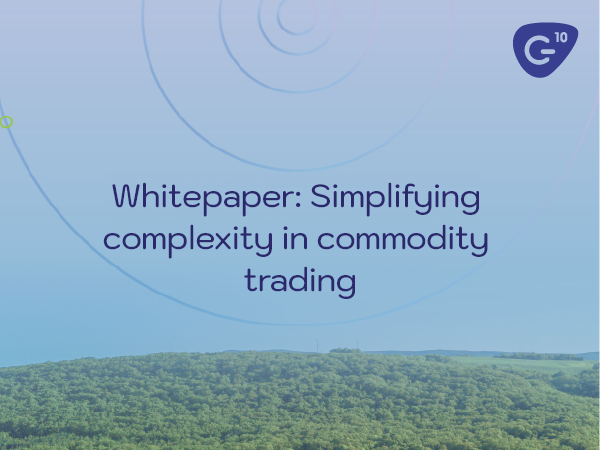This article is part of a series exploring CTRM and Commodity Management in cotton trading.
If you work in the cotton industry, you probably know just how challenging it can be to manage its financial and operational risks. From market fluctuations to counterparty and credit risk, there are countless risk factors that can impact your team’s performance and your bottom line.
That’s where Commodity Trading and Risk Management (CTRM) systems came into play in recent decades. These software solutions can help you analyse market data, manage your positions, and mitigate supply chain risk. But many cotton traders struggle with the limitations of traditional CTRM systems, and they can be just as frustrating as they are helpful.
That’s why many cotton industry professionals are turning to a new breed of Commodity Management Systems that offer a more comprehensive and flexible solution. In this article, we’ll explore the benefits of Commodity Management Systems for cotton producers, traders, and processors.
Limitations of traditional CTRM systems
CTRM systems have been around for decades, and they’ve become a staple in the cotton industry, but they have their limitations. These limitations are often caused by the old technology stacks that the systems are built on, as even those that are updated regularly are often held back by the decades-old technology that they are built on.
One of the biggest drawbacks of this older technology in traditional CTRM systems is that it creates a lack of flexibility. The lack of flexibility means that older CTRM systems are often more generalist platforms and do not have the support for the commodity-specific attributes and processes that traders need. This causes particular challenges in cotton, where there are many data variables (such as quality data) and variations in commodity processes (including take-up, HVI, financing and recap formats and timings).
These systems are also limited by their initial focus on one aspect of the trade lifecycle. They solve a specific purpose in managing risk, but this is not enough in modern trading businesses who create a competitive advantage through joined-up operations and effective data flows across the organisation. When businesses are improving processing across the entire cotton lifecycle, they cannot afford to have systems operating in silos.
Additionally, traditional CTRM systems can be difficult to integrate with other software solutions, which creates many sources of operational risk. There is a particularly high risk of errors and omissions when manually entering cotton data due to the large quantities of data involved. The system needs to be able to manage multiple quality fields for each bale, trace bales across virtual lots and containers, and create recap reports if the organisation is to be able to price contracts and manage financial risk.
Another limitation of some traditional CTRM systems is their inability to provide real-time data and reports. These systems typically rely on batch processing, which means that data is updated, and reports generated, periodically rather than in real-time. This creates inefficiencies in sharing data between teams, such as between trading and risk, slowing down decision-making and leaving potential gaps between reported and actual credit lines, trading and hedging strategies, and other business areas.
What is a cotton Commodity Management System?
Commodity Management Systems are designed to incorporate more of the trade lifecycle than a traditional CTRM, particularly in allowing trading companies to manage their operations alongside their trading and risk management. They often have a modern infrastructure which means that, as well as being more comprehensive, they are also a more flexible solution for managing cotton and other commodities. They are also usually available as cloud systems that can be securely accessed from anywhere.
For a Commodity Management System to be effective, it should be built with flexibility at its core as the logistics functionality needs to work with your organisation’s unique processes. And for cotton traders, this flexibility can even extend to supporting multiple workflows with different processing stages for cotton sourced from different regions.
You may also need to add multiple templates for automated document creation and a range of different pricing rules for each quality variable too. It is often this highly-specialised and business-specific functionality that traditional CTRM systems struggle to support in cotton trading, which is why the inherent flexibility of a Commodity Management System is essential for truly supporting cotton operations.
Commodity Management solutions also typically offer a range of features in addition to this logistics functionality, including real-time data processing, customisable workflows that automate processes and document creation, and integration with other software solutions. As well as reducing risk, these can provide significant time savings in importing HVI data and creating shipping documents, recaps and more.
The customisable workflows reduce operational risk as they ensure processes are being followed. Controls ensure documents are sent through the correct approval processes. And they include checks and alerts for a wide range of risks including that shipments meet the contract quality and weight tolerances, that contracts are within the counterparty’s credit limit, and more.
Commodity management systems also provide better traceability due to these workflows. The system automatically creates a digital log of every action, as well as who made it and when, creating a comprehensive and fully-auditable record of all your business’ activities. And the automation means that your entire team use the system to complete all their day-to-day activities – creating a complete audit trail without relying on your people to update records after the fact.
One of the key features of a Commodity Management System is its ability to provide real-time data, leading to better risk management and more efficient operations. Unlike traditional CTRM systems, Commodity Management Systems create reports and inter-functional data in real-time as traders and operators use them to manage their day-to-day activities. A good Commodity Management System such as Gen10’s CommOS can also integrate with other systems such as ERPs, accounting tools, and data analytics platforms to provide a real-time view of your entire operation.
Advantages of using a Commodity Management System for cotton industry professionals
Some of the key benefits of cotton Commodity Management Systems include:
- Improved collaboration – A Commodity Management System can improve collaboration between different departments. This leads to faster processing, fewer errors, better decision-making and ultimately a positive impact on your bottom line.
- Improved efficiency – By streamlining and automating processes a Commodity Management System can help improve overall efficiency. This can lead to cost savings and increased profitability.
- Better traceability – The system creates a clear digital audit of every action, tracing stock across your entire operation automatically.
- Better decision-making – Your team are provided with the information they need to make more informed decisions, whenever and wherever they need it.
- Enhanced risk management – Commodity Management Systems typically include the financial risk management of a CTRM system as well as the expanded operational risk management features. The range of controls and tools protect your organisation from a wide range of risks.
In conclusion, if you’re experiencing the frustration of CTRM limitations, it’s time to consider a Commodity Management System. These systems offer a comprehensive and flexible solution for managing every stage of the cotton trading process. With features like automation, real-time data processing and customisable workflows, a cotton Commodity Management System can help improve efficiency, enhance collaboration and reduce risk in even the most complex organisations.
And you don’t have to take our word for it – watch what Brighann Cotton had to say about their experience of upgrading to CommOS.
Want to read more?
Subscribe now for monthly updates
By submitting your details you agree that we can store your data and communicate with you. You can opt out of these communications at any time. Read all in our Privacy Policy.



